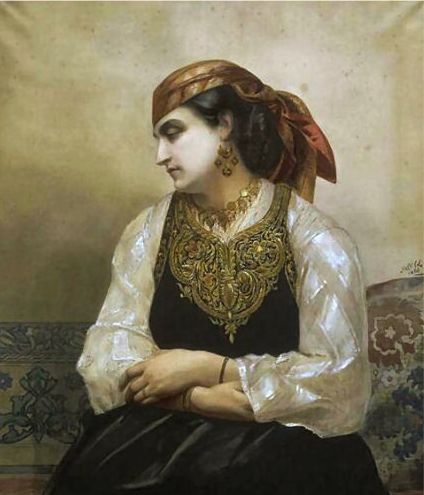Juive d'Alger (Jewess of Algiers), A Silvered, Parcel-Gilt and Enamelled Bronze
Bust on a Rouge Griotte Base
Bust on a Rouge Griotte Base
Cast from a model by Charles-Henri-Joseph Cordier, circa 1862
Inscribed Cordier 1862 and stamped with the Marnyhac, 4 rue de la Paix foundry mark
21 in (53.3 cm) high, including marble base
cf. Laure de Margerie, Édouard Papet, Facing the Other: Charles Cordier 1827-1905 Ethnographic Sculptor, exh. cat. Musée d'Orsay, 2004, p.184, no.338
'À l'atelier de Cordier', La Vie Parisienne, 14 January 1865
21 in (53.3 cm) high, including marble base
cf. Laure de Margerie, Édouard Papet, Facing the Other: Charles Cordier 1827-1905 Ethnographic Sculptor, exh. cat. Musée d'Orsay, 2004, p.184, no.338
'À l'atelier de Cordier', La Vie Parisienne, 14 January 1865
In the 1850s, Cordier was commissioned by the Musée d'Histoire Naturelle to execute a number of works concerning theories on race. Fascinated by the juxtaposition of colours and different materials, Cordier began to experiment with galvanoplastie, a process of silver plating which had been carried out in Paris by the silversmiths Christofle since 1842. Cordier was passionate about his new use of polychromy and in 1856, funded by the Ecole des Beaux-Arts, he set off for Algeria, fulfilling one of his childhood ambitions. He brought back with him multicoloured images of North Africa and presented at the Salon of 1857 no fewer than ten busts, each in various combinations of marble, onyx, bronze and enamel. (Cordier sent the completed bronze models to his brother-in-law, Devers, who applied the enamel highlights.) The majority of the models exhibited were purchased by the Beaux-Arts and replicas may now be seen in the Anthropology Gallery in the Musée de l'Homme in Paris.
Many critics were hostile to Cordier's new technique of polychrome sculpture, considering it to be an enemy to the monochromatic academic sculpture that recreated the statuary of the Antique. One enthusiast was the French writer Théophile Gautier who said, 'Mr Cordier, who is a colourist, made himself a rich palette of marbles, metals and stones, that he associates with a rare happiness. He dares being original in art which supports little originality. He deserves the attention of the critics as well as the interest of enthusiasts'. This evaluation of Cordier's work holds good today: he is considered one of the most important members of the Orientalist movement of the 19th century.
A model of Juive d'Alger in onyx, bronze and enamel is in the collections of the Musée des Beaux-Arts, Troyes, and the Van Gogh Museum, Amsterdam.
Many critics were hostile to Cordier's new technique of polychrome sculpture, considering it to be an enemy to the monochromatic academic sculpture that recreated the statuary of the Antique. One enthusiast was the French writer Théophile Gautier who said, 'Mr Cordier, who is a colourist, made himself a rich palette of marbles, metals and stones, that he associates with a rare happiness. He dares being original in art which supports little originality. He deserves the attention of the critics as well as the interest of enthusiasts'. This evaluation of Cordier's work holds good today: he is considered one of the most important members of the Orientalist movement of the 19th century.
A model of Juive d'Alger in onyx, bronze and enamel is in the collections of the Musée des Beaux-Arts, Troyes, and the Van Gogh Museum, Amsterdam.




















